Kinesiology Assignment 1: Interview & Article Review, University Name
VerifiedAdded on 2022/10/17
|6
|1139
|5
Homework Assignment
AI Summary
This assignment requires students to interview a kinesiologist and write a questionnaire about their career, including job duties, the best and worst parts of their job, characteristics for success, and career advice. The student interviewed Andrew Rogers, a kinesiologist working in a tertiary care hospital. The assignment also involves a review of an article focusing on "Positioning Theory: Kinesiology Students’ Experiences Teaching in an Adapted Aquatics Practicum", highlighting the collaborative approach of kinesiology undergraduates working with disabled students, emphasizing communication, conflicts, and socio-dynamic viewpoints. The article review summarizes the main ideas, relates it to chapter 15 of a physical education textbook, and includes references. The assignment also includes a Ted Talk video summary, highlighting how sugar affects the brain.
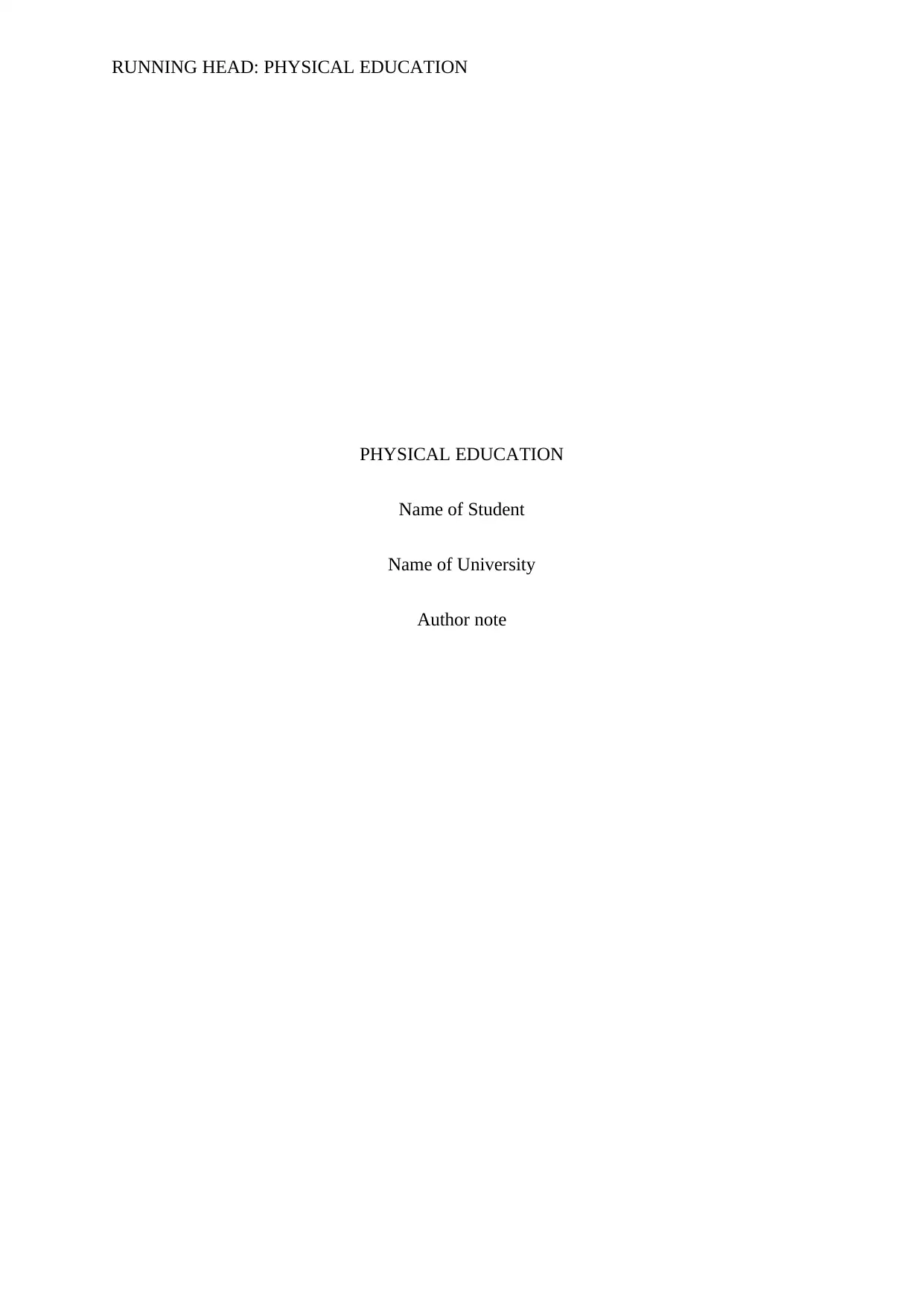
RUNNING HEAD: PHYSICAL EDUCATION
PHYSICAL EDUCATION
Name of Student
Name of University
Author note
PHYSICAL EDUCATION
Name of Student
Name of University
Author note
Paraphrase This Document
Need a fresh take? Get an instant paraphrase of this document with our AI Paraphraser
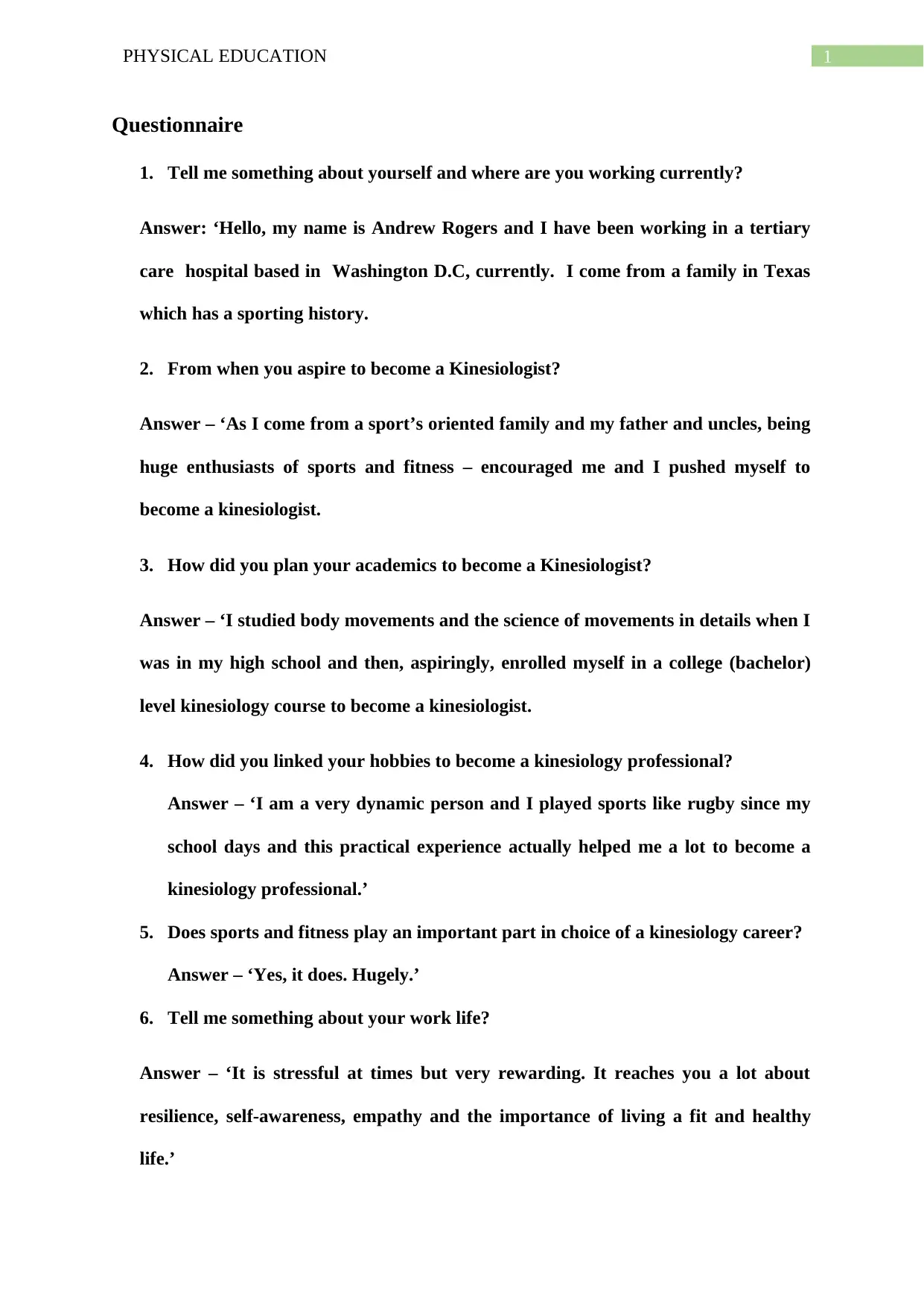
1PHYSICAL EDUCATION
Questionnaire
1. Tell me something about yourself and where are you working currently?
Answer: ‘Hello, my name is Andrew Rogers and I have been working in a tertiary
care hospital based in Washington D.C, currently. I come from a family in Texas
which has a sporting history.
2. From when you aspire to become a Kinesiologist?
Answer – ‘As I come from a sport’s oriented family and my father and uncles, being
huge enthusiasts of sports and fitness – encouraged me and I pushed myself to
become a kinesiologist.
3. How did you plan your academics to become a Kinesiologist?
Answer – ‘I studied body movements and the science of movements in details when I
was in my high school and then, aspiringly, enrolled myself in a college (bachelor)
level kinesiology course to become a kinesiologist.
4. How did you linked your hobbies to become a kinesiology professional?
Answer – ‘I am a very dynamic person and I played sports like rugby since my
school days and this practical experience actually helped me a lot to become a
kinesiology professional.’
5. Does sports and fitness play an important part in choice of a kinesiology career?
Answer – ‘Yes, it does. Hugely.’
6. Tell me something about your work life?
Answer – ‘It is stressful at times but very rewarding. It reaches you a lot about
resilience, self-awareness, empathy and the importance of living a fit and healthy
life.’
Questionnaire
1. Tell me something about yourself and where are you working currently?
Answer: ‘Hello, my name is Andrew Rogers and I have been working in a tertiary
care hospital based in Washington D.C, currently. I come from a family in Texas
which has a sporting history.
2. From when you aspire to become a Kinesiologist?
Answer – ‘As I come from a sport’s oriented family and my father and uncles, being
huge enthusiasts of sports and fitness – encouraged me and I pushed myself to
become a kinesiologist.
3. How did you plan your academics to become a Kinesiologist?
Answer – ‘I studied body movements and the science of movements in details when I
was in my high school and then, aspiringly, enrolled myself in a college (bachelor)
level kinesiology course to become a kinesiologist.
4. How did you linked your hobbies to become a kinesiology professional?
Answer – ‘I am a very dynamic person and I played sports like rugby since my
school days and this practical experience actually helped me a lot to become a
kinesiology professional.’
5. Does sports and fitness play an important part in choice of a kinesiology career?
Answer – ‘Yes, it does. Hugely.’
6. Tell me something about your work life?
Answer – ‘It is stressful at times but very rewarding. It reaches you a lot about
resilience, self-awareness, empathy and the importance of living a fit and healthy
life.’
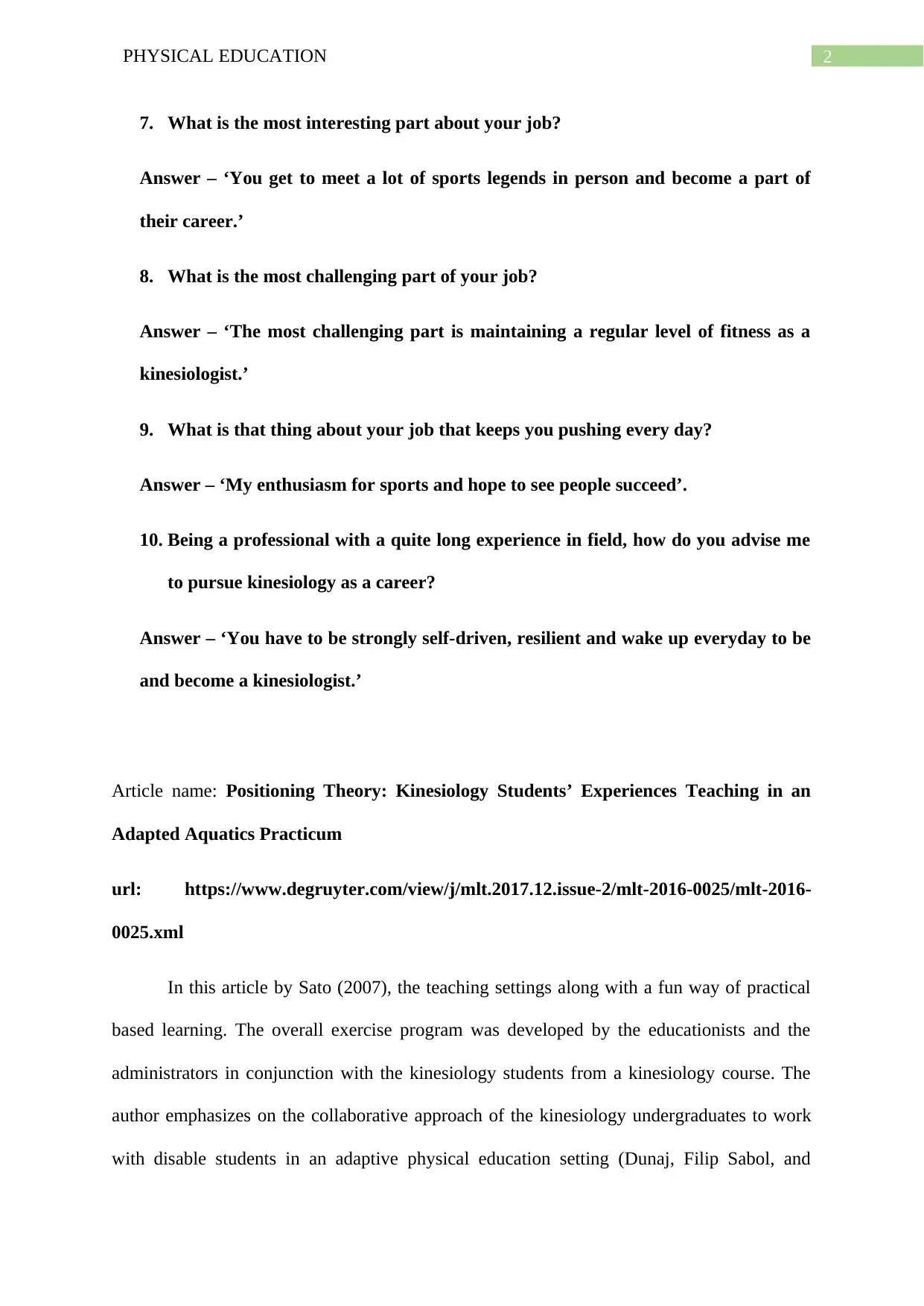
2PHYSICAL EDUCATION
7. What is the most interesting part about your job?
Answer – ‘You get to meet a lot of sports legends in person and become a part of
their career.’
8. What is the most challenging part of your job?
Answer – ‘The most challenging part is maintaining a regular level of fitness as a
kinesiologist.’
9. What is that thing about your job that keeps you pushing every day?
Answer – ‘My enthusiasm for sports and hope to see people succeed’.
10. Being a professional with a quite long experience in field, how do you advise me
to pursue kinesiology as a career?
Answer – ‘You have to be strongly self-driven, resilient and wake up everyday to be
and become a kinesiologist.’
Article name: Positioning Theory: Kinesiology Students’ Experiences Teaching in an
Adapted Aquatics Practicum
url: https://www.degruyter.com/view/j/mlt.2017.12.issue-2/mlt-2016-0025/mlt-2016-
0025.xml
In this article by Sato (2007), the teaching settings along with a fun way of practical
based learning. The overall exercise program was developed by the educationists and the
administrators in conjunction with the kinesiology students from a kinesiology course. The
author emphasizes on the collaborative approach of the kinesiology undergraduates to work
with disable students in an adaptive physical education setting (Dunaj, Filip Sabol, and
7. What is the most interesting part about your job?
Answer – ‘You get to meet a lot of sports legends in person and become a part of
their career.’
8. What is the most challenging part of your job?
Answer – ‘The most challenging part is maintaining a regular level of fitness as a
kinesiologist.’
9. What is that thing about your job that keeps you pushing every day?
Answer – ‘My enthusiasm for sports and hope to see people succeed’.
10. Being a professional with a quite long experience in field, how do you advise me
to pursue kinesiology as a career?
Answer – ‘You have to be strongly self-driven, resilient and wake up everyday to be
and become a kinesiologist.’
Article name: Positioning Theory: Kinesiology Students’ Experiences Teaching in an
Adapted Aquatics Practicum
url: https://www.degruyter.com/view/j/mlt.2017.12.issue-2/mlt-2016-0025/mlt-2016-
0025.xml
In this article by Sato (2007), the teaching settings along with a fun way of practical
based learning. The overall exercise program was developed by the educationists and the
administrators in conjunction with the kinesiology students from a kinesiology course. The
author emphasizes on the collaborative approach of the kinesiology undergraduates to work
with disable students in an adaptive physical education setting (Dunaj, Filip Sabol, and
⊘ This is a preview!⊘
Do you want full access?
Subscribe today to unlock all pages.

Trusted by 1+ million students worldwide
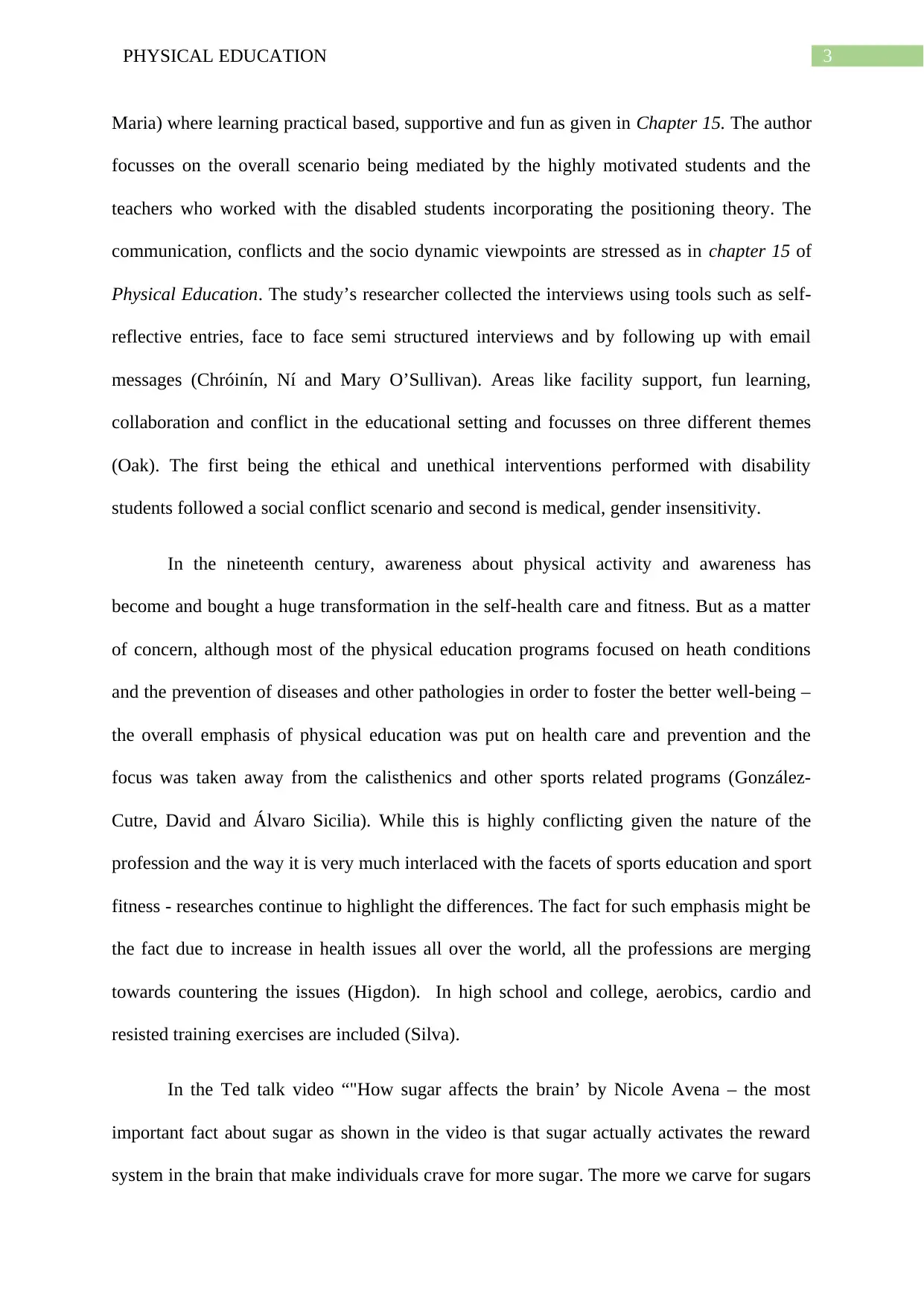
3PHYSICAL EDUCATION
Maria) where learning practical based, supportive and fun as given in Chapter 15. The author
focusses on the overall scenario being mediated by the highly motivated students and the
teachers who worked with the disabled students incorporating the positioning theory. The
communication, conflicts and the socio dynamic viewpoints are stressed as in chapter 15 of
Physical Education. The study’s researcher collected the interviews using tools such as self-
reflective entries, face to face semi structured interviews and by following up with email
messages (Chróinín, Ní and Mary O’Sullivan). Areas like facility support, fun learning,
collaboration and conflict in the educational setting and focusses on three different themes
(Oak). The first being the ethical and unethical interventions performed with disability
students followed a social conflict scenario and second is medical, gender insensitivity.
In the nineteenth century, awareness about physical activity and awareness has
become and bought a huge transformation in the self-health care and fitness. But as a matter
of concern, although most of the physical education programs focused on heath conditions
and the prevention of diseases and other pathologies in order to foster the better well-being –
the overall emphasis of physical education was put on health care and prevention and the
focus was taken away from the calisthenics and other sports related programs (González-
Cutre, David and Álvaro Sicilia). While this is highly conflicting given the nature of the
profession and the way it is very much interlaced with the facets of sports education and sport
fitness - researches continue to highlight the differences. The fact for such emphasis might be
the fact due to increase in health issues all over the world, all the professions are merging
towards countering the issues (Higdon). In high school and college, aerobics, cardio and
resisted training exercises are included (Silva).
In the Ted talk video “"How sugar affects the brain’ by Nicole Avena – the most
important fact about sugar as shown in the video is that sugar actually activates the reward
system in the brain that make individuals crave for more sugar. The more we carve for sugars
Maria) where learning practical based, supportive and fun as given in Chapter 15. The author
focusses on the overall scenario being mediated by the highly motivated students and the
teachers who worked with the disabled students incorporating the positioning theory. The
communication, conflicts and the socio dynamic viewpoints are stressed as in chapter 15 of
Physical Education. The study’s researcher collected the interviews using tools such as self-
reflective entries, face to face semi structured interviews and by following up with email
messages (Chróinín, Ní and Mary O’Sullivan). Areas like facility support, fun learning,
collaboration and conflict in the educational setting and focusses on three different themes
(Oak). The first being the ethical and unethical interventions performed with disability
students followed a social conflict scenario and second is medical, gender insensitivity.
In the nineteenth century, awareness about physical activity and awareness has
become and bought a huge transformation in the self-health care and fitness. But as a matter
of concern, although most of the physical education programs focused on heath conditions
and the prevention of diseases and other pathologies in order to foster the better well-being –
the overall emphasis of physical education was put on health care and prevention and the
focus was taken away from the calisthenics and other sports related programs (González-
Cutre, David and Álvaro Sicilia). While this is highly conflicting given the nature of the
profession and the way it is very much interlaced with the facets of sports education and sport
fitness - researches continue to highlight the differences. The fact for such emphasis might be
the fact due to increase in health issues all over the world, all the professions are merging
towards countering the issues (Higdon). In high school and college, aerobics, cardio and
resisted training exercises are included (Silva).
In the Ted talk video “"How sugar affects the brain’ by Nicole Avena – the most
important fact about sugar as shown in the video is that sugar actually activates the reward
system in the brain that make individuals crave for more sugar. The more we carve for sugars
Paraphrase This Document
Need a fresh take? Get an instant paraphrase of this document with our AI Paraphraser
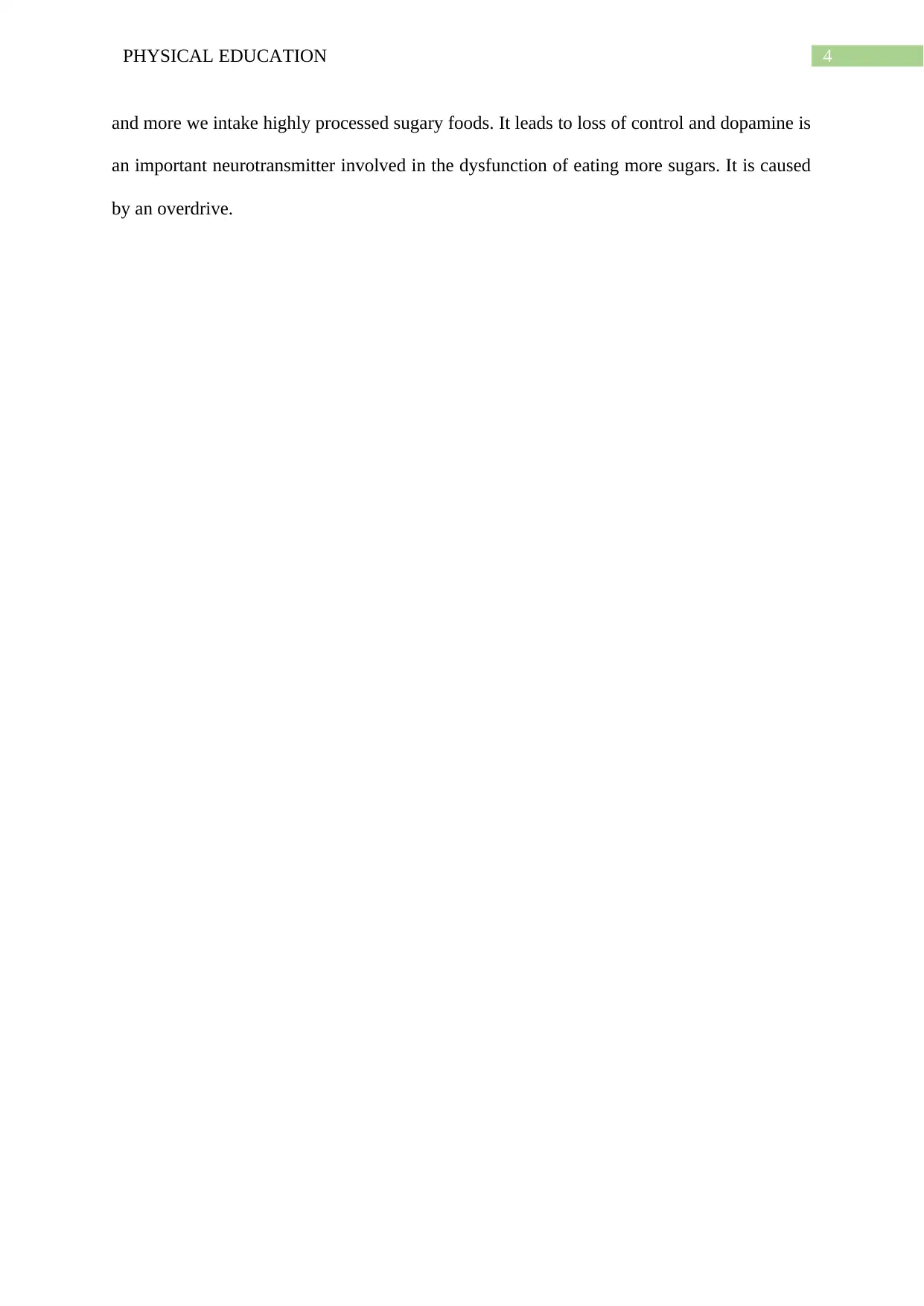
4PHYSICAL EDUCATION
and more we intake highly processed sugary foods. It leads to loss of control and dopamine is
an important neurotransmitter involved in the dysfunction of eating more sugars. It is caused
by an overdrive.
and more we intake highly processed sugary foods. It leads to loss of control and dopamine is
an important neurotransmitter involved in the dysfunction of eating more sugars. It is caused
by an overdrive.
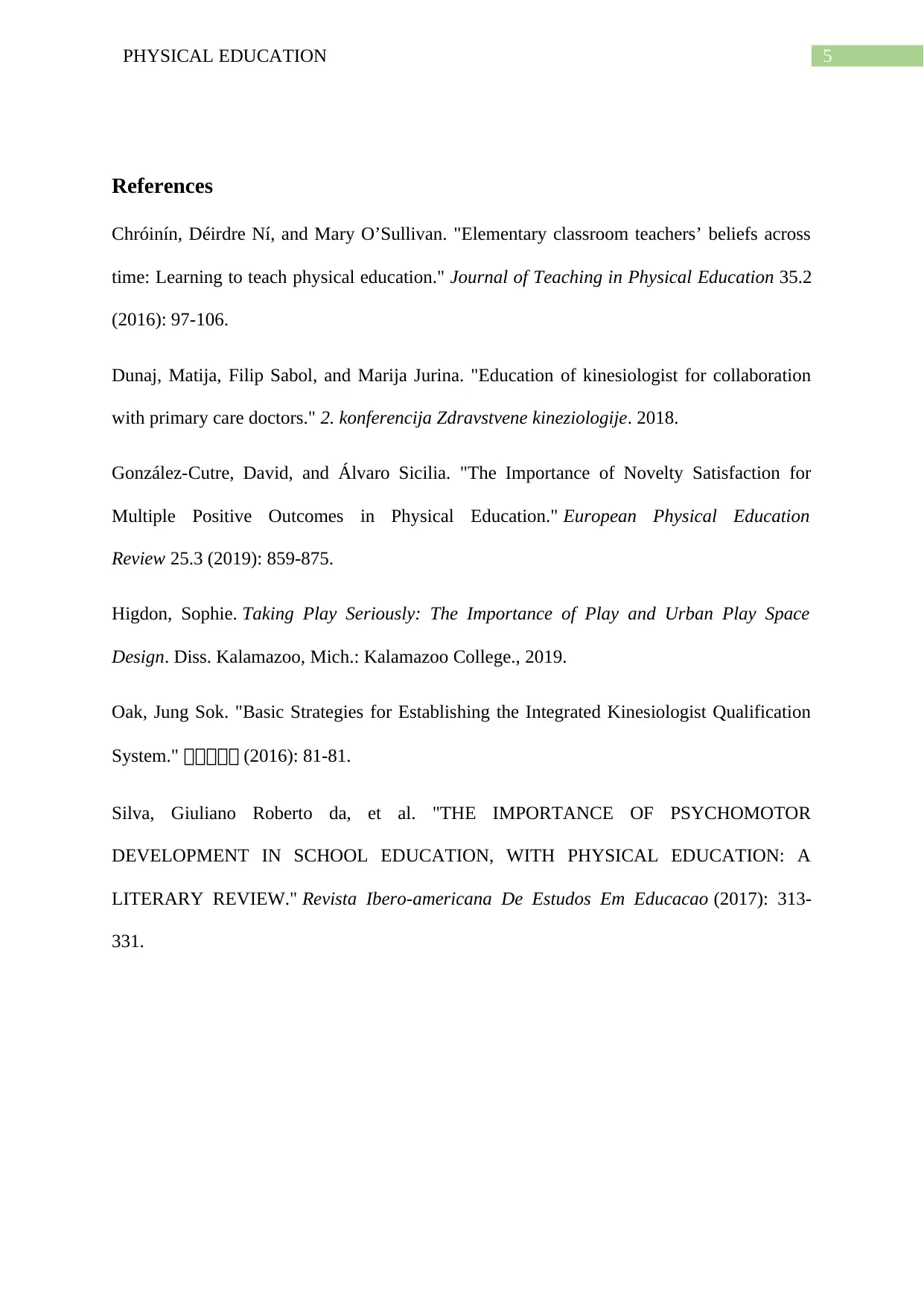
5PHYSICAL EDUCATION
References
Chróinín, Déirdre Ní, and Mary O’Sullivan. "Elementary classroom teachers’ beliefs across
time: Learning to teach physical education." Journal of Teaching in Physical Education 35.2
(2016): 97-106.
Dunaj, Matija, Filip Sabol, and Marija Jurina. "Education of kinesiologist for collaboration
with primary care doctors." 2. konferencija Zdravstvene kineziologije. 2018.
González-Cutre, David, and Álvaro Sicilia. "The Importance of Novelty Satisfaction for
Multiple Positive Outcomes in Physical Education." European Physical Education
Review 25.3 (2019): 859-875.
Higdon, Sophie. Taking Play Seriously: The Importance of Play and Urban Play Space
Design. Diss. Kalamazoo, Mich.: Kalamazoo College., 2019.
Oak, Jung Sok. "Basic Strategies for Establishing the Integrated Kinesiologist Qualification
System." 운운운운운 (2016): 81-81.
Silva, Giuliano Roberto da, et al. "THE IMPORTANCE OF PSYCHOMOTOR
DEVELOPMENT IN SCHOOL EDUCATION, WITH PHYSICAL EDUCATION: A
LITERARY REVIEW." Revista Ibero-americana De Estudos Em Educacao (2017): 313-
331.
References
Chróinín, Déirdre Ní, and Mary O’Sullivan. "Elementary classroom teachers’ beliefs across
time: Learning to teach physical education." Journal of Teaching in Physical Education 35.2
(2016): 97-106.
Dunaj, Matija, Filip Sabol, and Marija Jurina. "Education of kinesiologist for collaboration
with primary care doctors." 2. konferencija Zdravstvene kineziologije. 2018.
González-Cutre, David, and Álvaro Sicilia. "The Importance of Novelty Satisfaction for
Multiple Positive Outcomes in Physical Education." European Physical Education
Review 25.3 (2019): 859-875.
Higdon, Sophie. Taking Play Seriously: The Importance of Play and Urban Play Space
Design. Diss. Kalamazoo, Mich.: Kalamazoo College., 2019.
Oak, Jung Sok. "Basic Strategies for Establishing the Integrated Kinesiologist Qualification
System." 운운운운운 (2016): 81-81.
Silva, Giuliano Roberto da, et al. "THE IMPORTANCE OF PSYCHOMOTOR
DEVELOPMENT IN SCHOOL EDUCATION, WITH PHYSICAL EDUCATION: A
LITERARY REVIEW." Revista Ibero-americana De Estudos Em Educacao (2017): 313-
331.
⊘ This is a preview!⊘
Do you want full access?
Subscribe today to unlock all pages.

Trusted by 1+ million students worldwide
1 out of 6
Related Documents
Your All-in-One AI-Powered Toolkit for Academic Success.
+13062052269
info@desklib.com
Available 24*7 on WhatsApp / Email
![[object Object]](/_next/static/media/star-bottom.7253800d.svg)
Unlock your academic potential
Copyright © 2020–2025 A2Z Services. All Rights Reserved. Developed and managed by ZUCOL.




